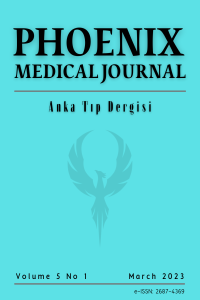Menopoz Durumunun Moleküler Meme Kanseri Alt Tipleri İle İlişkisi.
Meme kanseri, İmmunohistokimyasal analiz, Moleküler alt tip, Menopozal durum
Relationship of Menopausal Status with Molecular Breast Cancer Subtypes
___
- El Saghir NS, Seoud M, Khalil MK, Charafeddine M, Salem ZK, Geara FB, et al. Effects of young age at presentation on survival in breast cancer. BMC Cancer. 2006;6:1–8.
- Goldhirsch A, Winer EP, Coates AS, Gelber RD, Piccart-Gebhart M, Thürlimann B, et al. Personalizing the treatment of women with early breast cancer: Highlights of the St Gallen international expert consensus on the primary therapy of early breast Cancer 2013. Ann Oncol. 2013;24(9):2206–23.
- Eroglu A, Cicek E. Meme kanserinde moleküler alt tiplere göre cerrahi tedavi yaklaşımları. Yeni Tıp Derg. 2014;31:83–7.
- Ogawa Y, Hai E, Matsumoto K, Ikeda K, Tokunaga S, Nagahara H, et al. Androgen receptor expression in breast cancer: Relationship with clinicopathological factors and biomarkers. Int J Clin Oncol. 2008;13(5):431–5.
- Wiechmann L, Sampson M, Stempel M, Jacks LM, Patil SM, King T, et al. Presenting features of breast cancer differ by molecular subtype. Ann Surg Oncol. 2009;16(10):2705–10.
- Giuliano AE, Connolly JL, Edge SB, Mittendorf EA, Rugo HS, Solin LJ, et al. Breast Cancer-Major changes in the American Joint Committee on Cancer eighth edition cancer staging manual. CA Cancer J Clin. 2017;67(4):290–303.
- Anders CK, Hsu DS, Broadwater G, Acharya CR, Foekens JA, Zhang Y, et al. Young age at diagnosis correlates with worse prognosis and defines a subset of breast cancers with shared patterns of gene expression. J Clin Oncol. 2008;26(20):3324–30.
- Keegan THM, DeRouen MC, Press DJ, Kurian AW, Clarke CA. Occurrence of breast cancer subtypes in adolescent and young adult women. Breast Cancer Res. 2012;14(2):R55.
- Carey LA, Perou CM, Livasy CA, Dressler LG, Cowan D, Conway K, et al. Race, breast cancer subtypes, and survival in the Carolina Breast Cancer Study. J Am Med Assoc. 2006;295(21):2492–502.
- Albergaria A, Ricardo S, Milanezi F, Carneiro V, Amendoeira I, Vieira D, et al. Nottingham Prognostic ındex in triple-negative breast cancer: A reliable prognostic tool? BMC Cancer. 2011;11.
- Lin NU, Vanderplas A, Hughes ME, Theriault RL, Edge SB, Wong YN, et al. Clinicopathologic features, patterns of recurrence, and survival among women with triple-negative breast cancer in the National Comprehensive Cancer Network. Cancer. 2012;118(22):5463–72.
- Faheem M, Mahmood H, Khurram M, Qasim U, Irfan J. Estrogen receptor, progesterone receptor, and Her 2 Neu positivity and its association with tumour characteristics and menopausal status in a breast cancer cohort from northern Pakistan. Ecancermedicalscience. 2012;6(1):1–8.
- Li CY, Zhang S, Zhang XB, Wang P, Hou GF, Zhang J. Clinicopathological and prognostic characteristics of triple- negative breast cancer (TNBC) in chinese patients: A retrospective study. Asian Pacific J Cancer Prev. 2013;14(6):3779–84.
- Wang K, Ren Y, Li H, Zheng K, Jiang J, Zou T, et al. Comparison of clinicopathological features and treatments between young (≤40 years) and older (>40 years) female breast cancer patients in West China: A retrospective, epidemiological, multicenter, case only study. PLoS One. 2016;11(3):1–14.
- Kocaöz S, Korukluoǧlu B, Parlak Ö, Doǧan HT, Erdoǧan F. Comparison of clinicopathological features and treatments between pre- And postmenopausal female breast cancer patients - A retrospective study. Prz Menopauzalny. 2019;18(2):68–73.
- Susan Cleator 1, Wolfgang Heller RCC. Triple-negative breast cancer: therapeutic options. Lancet Oncol. 2007;8(1):235–44.
- Yayın Aralığı: Yılda 3 Sayı
- Başlangıç: 2019
- Yayıncı: İbrahim İKİZCELİ
COVID-19 Pandemi Salgınıyla Yeniden Artan Metanol Zehirlenmeleri: Olgu Serisi
Aynur YURTSEVEN, Cemil KAVALCI
Ece YİĞİT, Tuba MERT, Melike Rusen METİN
Özel Radyografi Bulgusu ile Bilateral Triquetrum Kırığı
Enis ADEMOĞLU, Serdar ÖZDEMİR, Serkan Emre EROĞLU
Menopoz Durumunun Moleküler Meme Kanseri Alt Tipleri İle İlişkisi.
Şeref DOKCU, Mehmet Ali ÇAPARLAR, Özhan ÇETİNDAĞ, Musluh HAKSEVEN, Aydan EROĞLU
Pandeminin Dilemması: İlaç Yan Etkisi mi? Ya COVID-19'sa?
Anıl AKÇA, Sevil ALKAN, Taylan ÖNDER, Safiye Bilge GÜÇLÜ KAYTA, Servan VURUCU, Cihan YÜKSEL
Yoğun Bakım Ünitelerinde Çalışan Hemşirelerde Koronofobinin Değerlendirilmesi
Abdullah ÖZDEMİR, Seyfi KARTAL, Hizir KAZDAL, Halil İbrahim ÇAKMAK
Tuğrul ERTUĞRUL, Gökçen SEVİLGEN
Acil Serviste Takılan Santral Venöz Kateterlerin Değerlendirilmesi
Mehmet KIY, Ali DUMAN, Selçuk Eren ÇANAKÇI, Yunus Emre ÖZLÜER, Mustafa Emin SERİN, Ayhan AKÖZ
